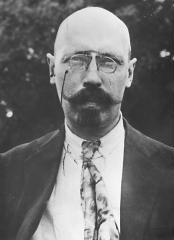
Pulkovo is an international airport serving St. Petersburg, Russia. It consists of one terminal which is located 23 km (14 mi) south of the city centre. The airport serves as a hub for Rossiya Airlines and as focus city for Smartavia. It is responsible for serving the citizens of Saint Petersburg, as well as the Leningrad Oblast: a total of 6,120,000 people. It is the thirty-first-busiest airport in Europe for 2022.

The Ioffe Physical-Technical Institute of the Russian Academy of Sciences is one of Russia's largest research centers specialized in physics and technology. The institute was established in 1918 in Petrograd and run for several decades by Abram Ioffe. The institute is a member of the Russian Academy of Sciences.

Nevsky Prospect is a main street located in the federal city of St. Petersburg in Russia. Its name comes from the Alexander Nevsky Lavra, the monastery which stands at the eastern end of the street, and which commemorates the Russian hero Prince Saint Alexander Nevsky (1221–1263). Following his founding of Saint Petersburg in 1703, Tsar Peter I planned the course of the street as the beginning of the road to Novgorod and Moscow. The avenue runs from the Admiralty in the west to the Moscow Railway Station and, after veering slightly southwards at Vosstaniya Square, to the Alexander Nevsky Lavra.

Marian Marianovich Peretyatkovich (Russian: Мариа́н Мариа́нович Перетя́ткович; 23 August 1872, in Usychi, Volhyn 22 May 1916, in Kyiv was a Russian and Ukrainian architect. His premature death at the age of 43 limited his career to only eight years of independent practice, however, he managed to excel in a rational variety of late Art Nouveau, Renaissance Revival and Russian Revival in Saint Petersburg and Moscow. He is sometimes compared with Louis Sullivan on account of his insistence on functionality of office buildings.

Zaryadye is a historical district in Moscow established in the 12th or 13th century within Kitai-gorod, between Varvarka Street and the Moskva River. The name means "the place behind the rows", i.e., behind the market rows adjacent to Red Square.

Gorokhovaya Street is a north-south thoroughfare in the Central Business District of Saint Petersburg.

Leningradsky Prospekt, or Leningrad Avenue, is a major arterial avenue in Moscow, Russia. It continues the path of Tverskaya Street and 1st Tverskaya-Yamskaya Street north-west from Belorussky Rail Terminal, and changes the name once again to Leningrad Highway past the Sokol metro station. The Highway continues its way to Saint Petersburg via Tver.

Gersz Salwe, also written Salve, Polish: Henryk Jerzy Salwe, was a Polish chess master.

Yakimanka District is a district of Central Administrative Okrug of the federal city of Moscow, Russia. Population: 26,578 (2010 Census); 22,822 (2002 Census).

Alexander Alexandrovich Bashilov was a Russian general officer of Napoleonic Wars period, later engaged in urban planning of Moscow and its suburbs.

Staraya Square, literally "Old Square", connects Ilyinka Street with Varvarka Gates Square in central Kitai-gorod area of Moscow, Russia. It is not a square in a true sense, but a street, normally closed to regular city traffic. The historical building located at 4 Staraya Square, was the headquarters of the Central Committee of the Communist Party of the Soviet Union, thus Staraya Square became a symbol for the Party apparatus. Now the building is the headquarters of Presidential Administration of Russia, retaining its symbolic value. It is one of the Central Squares of Moscow forming an arc around Moscow Kremlin and Kitai-gorod.

The Tolstoy House is a well-known apartment building in St. Petersburg, located at 15-17 Rubinstein Street and 54 Fontanka Embankment. The building was constructed in 1910–1912 under the aegis of Major-General Count Mikhail Pavlovich Tolstoy, nephew of the 1812 war hero P. A. Tolstoy. The architect Fyodor Lidval designed it in Nordic Art Nouveau. The construction is interesting for its inner street with three connected yards where the facades were decorated as richly as the front ones. Three-storey arches leading to the inner street are the architectural dominants of the compositions.

Pravda 10 is a landmark building of the notable area of Saint-Petersburg often referred to as Dostoevsky's St. Petersburg by locals. Over time it has served as a residence of merchants, a tenement house, and later on, in the Soviet Union period, the building was used as Railway Club and afterwards as the Union of Food Workers’ “Palace of Culture”. After many years of abandonment due to the fire which destroyed most part of the building, it went through major restoration of what was left of the construction, and renovation to open as the one and only hotel under the name of The State Hermitage Museum.

Valentin[e] Alexandrovich Dogiel was a Russian and Soviet zoologist, specialized in parasitology and protozoology. He has been considered the founder of evolutionary parasitology and was the author of an influential textbook of parasitology.

The Fontanka Embankment is a street in Saint Petersburg that follows the course of the Fontanka River from its origin as it diverges from the Neva River up to its confluence with the Great Neva. In 1762–1769 the general plan of city development was developed by the State Special Committee, headed by Aleksei Kvasov. Following this plan, in the 1780s the shores were embanked in granite by architect Giacomo Quarenghi. The Fontanka Embankment was used as a border of Saint Petersburg central part.

Sampsoniyevskoye is a municipal okrug occupying the southern part of Vyborgsky District of the federal city of Saint Petersburg, Russia.

Kantemirovskaya street is a motor road of regional significance in Sampsonievskoye municipal okrug in Vyborgskiy district and partly in Primorskiy district of Saint Petersburg, Russia. It became rather important for the city's north and east and busy with traffic after its 1980s reconstruction and completion of Kantemirovsky bridge as a transit link between Vyborg Side and Petrograd Side. The street got its current name in honour of the 1942 Soviet victory in the battle of Kantemirovka town in Voronezh Oblast province in southern Russia.

















